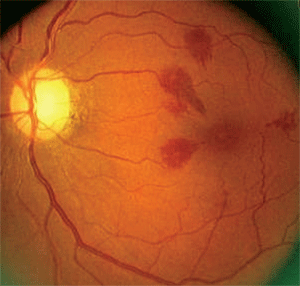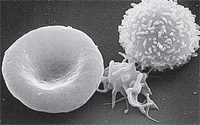 Hematology is the study of the cellular elements of blood. The American Society of Hematology refers to blood as “the vital connection”—it is the body’s main carrier of oxygen and nutrients.1 It helps keep the body at optimal temperature, carries hormones to cells and sends antibodies to fight infection.
Hematology is the study of the cellular elements of blood. The American Society of Hematology refers to blood as “the vital connection”—it is the body’s main carrier of oxygen and nutrients.1 It helps keep the body at optimal temperature, carries hormones to cells and sends antibodies to fight infection.
Blood contains clotting factors to help tissues heal after injury. It brings waste products to the kidneys and liver, which filter and clean the blood.
Common hematologic disorders include sickle cell hemoglobinopathy, anemia, bleeding and clotting disorders, and blood cancers.1-3 Ocular manifestations of hematologic disease may result in significant visual consequences and can be an indication of serious systemic complications. Retinal hemorrhages in leukemia may be dot-shaped, flame-shaped, intraretinal, subretinal or subhyaloid.
In Part 1 of this two-part column, we present an overview of blood’s components, as well as its production. We also will review some laboratory tests that evaluate hematologic function.
Blood Basics
About 7% to 8% of a person’s total body weight is blood.1,2 Blood runs through veins, arteries and capillaries. It’s made up of about 45% solids (cells) and 55% fluids (plasma), and has four major components: plasma, red blood cells, white blood cells and platelets.1-3
• Plasma. Plasma is 90% water, so it’s efficient in transporting blood cells throughout the body. In addition to water, plasma contains salts and glucose.

Retinal hemorrhages in leukemia may be dot-shaped, flame-shaped, intraretinal, subretinal or subhyaloid. The image above shows large, white, centered, flame-shaped hemes.
It also consists of proteins that carry important nutrients to the body’s cells and strengthen the immune system.
• Red blood cells. There are three types of blood cells that circulate within the plasma: red blood cells (erythrocytes), white blood cells (leukocytes) and platelets (thrombocytes).
Of these cells, erythrocytes are the most abundant. Their biconcave shape and lack of a nucleus enable red blood cells to change their shape in order to fit through small vessels.
Hemoglobin, a protein contained in red cells, helps carry oxygen from the lungs to the rest of the body, returning carbon dioxide to the lungs so it can be exhaled.1-3
• White blood cells. The leukocytes protect body tissues against infection. Neutrophils, the most common white cells, rapidly find bacteria and fungi, and neutralize them by phagocytosis.
The other major type of white blood cell is a lymphocyte. There are two main populations of these cells. T lymphocytes help regulate the function of other immune cells and directly attack various infected cells and tumors. B lymphocytes (also known as bursa-dependent lymphocytes) are involved in the production of antibodies that respond to bacteria, viruses and tumor cells.4
Other white blood cell types include eosinophils, basophils and monocytes. (For a more detailed discussion of immunology, see our previous columns: “
The Body Goes to War [Part 1],” July 2009, and “
The Body Goes to War [Part 2],” September 2009.)
• Platelets. Platelets are small fragments of cells that aid in the coagulation process. Platelets gather at the site of an injury, sticking to the lining of the injured blood vessel and forming a platform on which clotting can occur.
This results in the formation of a fibrin clot, which covers the wound and prevents blood from leaking out. Fibrin also forms the initial scaffolding upon which new tissue forms, thus promoting healing.1,2
Production of Blood
Blood cells develop from hematopoietic stem cells and are formed in the bone marrow through the highly regulated process of hematopoiesis. These stem cells are capable of transforming into red cells, white cells and platelets.4,5
Production of red blood cells is controlled by erythropoietin, a hormone produced primarily by the kidneys. Red blood cells start as immature cells in the bone marrow and are released into the bloodstream after about seven days of maturation. The red blood cell survives for 120 days, on average.4,5

A red blood cell, platelet and white blood cell (left to right), depicted by scanning
electron microscopy.
Hematopoietic stem cells can be found circulating in the blood and bone marrow of people of all ages, as well as in the umbilical cords of newborn babies.
Stem cells from all three sources may be used to treat a variety of hematologic and other types of diseases, including leukemia, lymphoma, bone marrow failure and immune disorders.5
Patients who inquire about becoming hematopoietic stem cell donors can be directed to the National Marrow Donor Program (
www.marrow.org), where they can access appropriate resources on donating bone marrow, umbilical cord blood or peripheral blood stem cells.
Evaluating the Blood
Clinicians should perform a targeted review of systems for those patients with a history of hematologic disease, as well as those suspected of having a blood disorder.
A complete blood count (CBC) is ordered as part of a routine health screening and to check for any abnormalities. This test counts and evaluates the size and shape of platelets, red and white blood cells and types of white blood cells. It also measures hemoglobin and hematocrit.
Review of Systems for Hematologic Disorders
• Easy bruising
• Easy bleeding
• Anemia
• Blood clots
• Transfusion history
A hematocrit is the percentage of whole blood volume that is made up of red blood cells. CBC results may help diagnose conditions like infection and anemia.6
The CBC may be ordered with white blood cell differential. The differential count reveals if these cells are present in normal proportion to one another, if one cell type is increased or decreased, or if immature cells are present.
The platelet count and plasma clotting tests (prothombin time, partial thromboplastin time and thrombin time) may be used to evaluate bleeding and clotting disorders. Hemoglobin testing is normally ordered as a part of the CBC. It also is repeated in patients who have ongoing bleeding problems or chronic anemia or polycythemia.6,7
You may also order a blood smear. In a normal blood smear, red blood cells appear as regular, round cells with a pale center. Variations in the size or shape of these cells may suggest a blood disorder. More sensitive and specific testing can be ordered when a particular hematologic disease is suspected.7 (We’ll cover some of these tests in our next column.)
Blood is a complex, specialized fluid and vital connection within the body. However, many Americans have little knowledge about blood disorders and hematology in general.
Hemotologic disorders may result from excess or impaired production of blood cells, destruction of blood cells and abnormal function of existing blood cells.
Stay tuned for “Hematology (Part 2): Hemoglobin Abnormalities and the Eye,” which will appear in the November issue.
1. American Society of Hematology. Blood: The Vital Connection. Available at:
www.hematology.org/Patients. Accessed August 2, 2011.
2. Whitaker RH. Anatomy of the heart. Medicine. 2006 May 1;34(5):163-5.
3. Fauci AS, Braunwald E, Isselbacher KJ, et al , eds. Harrison’s Principles of Internal Medicine. 14th ed. New York: McGraw-Hill; 1998:1345-52.
4. Parkin J, Cohen B. An overview of the immune system. Lancet. 2001 Jun 2;357(9270):1777-89.
5. Orkin SH, Zon LI. Hematopoiesis and stem cells: plasticity versus developmental heterogeneity. Nat Immunol. 2002 Apr;3(4):323-8.
6. Pagana KD, Pagana TJ. Mosby’s Diagnostic and Laboratory Test Reference. 8th ed. St. Louis: Mosby, Inc.; 2007:290.
7. Stiene-Martin EA, Lotspeich-Steininger CA, Koepke JA. Clinical Hematology: Principles, Procedures, Correlations. 2nd ed. Philadelphia: Lippincott-Raven Publishers; 1998.

